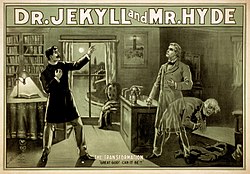(See Doppelgängers and Vampires: Part I and Doppelgängers and Vampires: Part II)
Folklore and popular culture have been ever brimful with the supernatural and paranormal, but it seems particularly prevalent in our present 21st century moment.
Folklore and popular culture have been ever brimful with the supernatural and paranormal, but it seems particularly prevalent in our present 21st century moment.
A fascination with horror accompanied the social sea-changes of the Industrial Revolution in the latter half of the 18th century and the 19th century. The 20th, experiencing the paranoia of Joseph McCarthy's House on Un-American Activities Hearings, witnessing the nuclear destruction of Hiroshima and Nagasaki, living through the 1950s Cold War threat of nuclear annihilation – saw tales of monsters, aliens, and mad scientists emerge again as the metaphorical embodiment of the bogeymen who engendered a collective panic smoldering just below the surface of normalcy.
When faced with paradigm shifts of such magnitude that they threaten to undermine our sense of who we are and what our place in the universe is, we turn to tales of heavenly afterlife to assuage our fear of death; of doppelgängers and demonic possession as metaphors for our terror of psychological fracture; of vampires, zombies, aliens, and pandemics as allegories of invasion; and of apocalypse as a manifestation of our foreboding of cultural, social, economic, and environmental collapse.
When faced with paradigm shifts of such magnitude that they threaten to undermine our sense of who we are and what our place in the universe is, we turn to tales of heavenly afterlife to assuage our fear of death; of doppelgängers and demonic possession as metaphors for our terror of psychological fracture; of vampires, zombies, aliens, and pandemics as allegories of invasion; and of apocalypse as a manifestation of our foreboding of cultural, social, economic, and environmental collapse.
A similar angst, brought on by social inequalities, betrays us into justifying our biases about the social order. Unfortunately, bigotry of various stripes is also nothing new, nor is the rise of a plutocratic class that threatens meaningful democracy – which does not make their periodic resurgence any less worrisome.
Just as the misery and privations of industrialization sent the 19th century working class in search of escape, so too have economic breakdown since 1980 for most Americans, the financial crisis of 2008, and the ecological collapse to which we are going to such lengths to remain oblivious, set us in search of easy culprits to blame and effortless, uncomplicated quick fixes in the form of angels, psychics, and superheroes.
The parallel escalation of intolerance – religious fundamentalism, racism, partisan politics, misogyny, homophobia, xenophobia – and horror thrillers reflects a society that collectively has come to favor fantasy and scapegoating over intellectual perspicacity. Fox News scoffs at scholarly inquiry, scientific and otherwise, as the hocus-pocus of a liberal “elite,” while educational opportunity is reserved for the 1%.
The reality for the remaining 99 is a nation in which social mobility increasingly means an inevitable downward path, and one definition of health comes more and more to mean medicating diabetes, not preventing it. Never mind the big picture. We are getting poorer, sicker, and more anxious as our short-term future becomes more uncertain.
Add to the mix the inexorable expansion of automation and technological innovation that will continue to erode employment opportunities for those with minimal skills; the astronomical social costs of obesity and aging; and the ravages of ecological devastation that are already spoiling arable land, leaving communities waterless, and costing trillions in extreme weather events – a dystopian future looks chillingly inevitable.
How do these realities affect a country for which the idea of the self-made man is so intrinsic? The belief in reinvention and self-actualization has always been central to the American mythos – from Benjamin Franklin to Horatio Alger to Jay Gatsby to Steve Jobs.
Now that upward mobility is no longer a possibility for a growing percentage of the citizenry, are we suffering a collective crisis of identity? Does that explain the emergence of the doppelgänger, in multiple variations on the theme, as one of the most popular tropes of 2014?


No comments:
Post a Comment